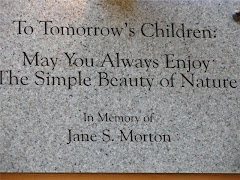Note: Scroll down right margin to CODE "(A-49) BIRD ID" for free videos and free articles about bird identification.
I've got these 6 Websites bookmarked and use them often
Welovebirds.org: The Natural Resources Defense Council (NRDC) has partnered with the Cornell Lab of Ornithology to create this site as a place for bird-lovers to share stories and information about birds and to help protect birds from activities that harm them and their habitat. You become a member for free to enjoy all the benefits, like a Forum and various birding interest groups to join (for free) and discuss birds.
Patuxent Wildlife Research Center: Great site because of the bird ID photos and tips on identifying birds. Lots of migratory bird data.
ENature.com: I joined this Website, too. Gotta have it bookmarked! Almost 6,000 individual species are listed with the same data set used to create the printed Audubon Field Guides. All the data has been carefully reviewed and vetted by leading biologists, zoologists and other natural history specialists. You can listen to bird songs, etc., that all download instantly; I used it to hear the difference between Red-bellied and Red-headed woodpeckers.
Wildbirds.com: This web site is for backyard birders and fledgling birders. The Website answers questions and contains great photos of birds as well. There are new discussion forums that are very interesting.
Naturesongs: A great site with thousands of animal species and their calls and sounds. This one is for birds only. I just listened to warblers, vireos, and chicadee calls and downloaded them. Truly amazing variety of excellent bird songs here!
The Cornell Lab of Ornithology All About Birds: A truly amazing site to help in identifying unknown birds. Great photos and ID tips, plus instant songs to listen to. I also like how they describe the bird's song before you play it; it helps in remembering and in differentiating between similar-sounding songs.
Related Posts:
Mystery Baby Hummingbird Nurtured Back To Health
Bald Eagles & Winter Birds Survive
Video: Cooper's Hawk Kill At Bird Feeder
Largest Bird Field Guide You'll Find Anywhere!
A Video for Red-sholder Hawk Lovers
Sharp-shinned Hawk Devours Starling
Anne Murray Sings About Snow Buntings
Robert Morton, M.Ed., Ed.S. writes about the natural world. Questions? Comments? Have a photo, personal story, article, meeting, workshop, or seminar you'd like to share? We'll publish it free-of-charge on this site...for the good of the order! Contact us on the secure Bpath Mail Form.



